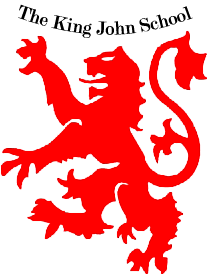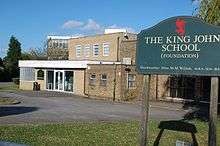The King John School
 | |
| Established | 1949 |
|---|---|
| Type | Academy |
| Headteacher | Margaret Wilson |
| Location |
Shipwrights Drive South Benfleet Essex SS7 1RQ England Coordinates: 51°33′20″N 0°35′35″E / 51.5556°N 0.5931°E |
| Local authority | Essex |
| DfE URN | 115319 Tables |
| Ofsted | Reports |
| Students | 1861 |
| Gender | Mixed |
| Ages | 11–18 (inc. Sixth Form) |
| Colours | Red & Black |
| Website |
www |
The King John School, often abbreviated to King John, is a secondary academy school with a sixth form in South Benfleet, Essex, England. It is named after the King John of England. The main school building was built prior to 1958: contrary to popular belief this building was never designed, nor used, as a hospital. As of January 2010, the school has an enrollment of 1861 students.[1]
School Tutors
The school has 10-12 tutor groups, with around 30 pupils in each tutor (Bar the 2014 Yr 7 with 12 tutor groups). The tutor groups are set in a format of the year, then the number of the tutor group, for example, 7-07, 8-07, 9-07, 10-07, 11-07, the year changing as the students progress throughout the school. Each year group has a Head of Year, who is a step above the normal tutors, and organizes activities such as end of year trips, and also deals with some of the disciplinary aspects, such as detentions.
These tutor groups are designed to create a closer social group for students in Year 7 and Year 8. This is achieved by keeping tutor groups together for non-core subjects in the first two years. In Years 9, 10 and 11, however, the tutor groups become less prominent, and the classes are reorganised, allowing for a fresh experience, and space for change.
A similar system applies to the Sixth-Form, except each tutor group begins with 12 or 13 depending on what year the sixth former is in, for example, 12-01 and 13-01.
Prefects

In Year 10, students with a good behavioural record become eligible to apply for the role of Prefect. Prefect within the school are permitted a distinguishing tie (see right) and badge, similarly to other local secondary schools. Prefect Status, as it is referred to, is granted to just over 100 students. These students take on additional responsibilities within the school, such as conducting tours to visitors and monitoring the school during breaktimes. There are also often additional benefits, such as celebratory dinners, awarded to the Prefects.
Senior Prefect Team
Towards the end of Year 10, Prefects also have the opportunity to apply to the Senior Prefect team. This is composed of 12-14 students, who assist with the management of the Prefect team, usually alongside the Head of Year for Year 11. Within this team, after an extensive interviewing and appraisal process, roles are awarded to form a structure within the Senior Prefect Team. This is as follows:
| Head Boy, Head Girl | One Male, One Female |
| Deputy Head Boy, Deputy Head Girl | Two Male, Two Female |
| Senior Prefect | Three Male, Three Female (sometimes four of each) |
There is no chain of command within the Senior Prefect Team, although the Head Boy and Head Girl are traditionally called upon first for public engagements.
Facilities
The King John School has over 100 classrooms, roughly divided into department 'blocks'. The majority of the classrooms are ambiguous, with generic facilities. Interactive Whiteboards are present in every classroom, and there are a number of notebook sets for use in classrooms.
The school has over 600 computers in total, using Windows 7 Enterprise. Each student has an account on the school network, and all of their personal documents are stored in the server. This allows students to access their documents from every computer in the school. Students also have their own school email where work can be sent to and from teachers.
Results


Results of the King John School from 2007 to 2011:
- 81% 5x A*-C GCSEs
- 10% English Bacc
- 1022.2 CVA
- 779.9 A/AS Points
- Rated 11th Secondary School in terms of GCSE Results
- Rated 30th Sixth Form in terms of A/AS Points
- % of KS4 achieving Level 2 threshold including English and mathematics
- 2007 - 73%
- 2008 - 70%
- 2009 - 78%
- 2010 - 81%
- 2011 - 96%
References
- ↑ "The King John School". edubase.gov.uk. Department for Education, UK. Retrieved July 5, 2011.